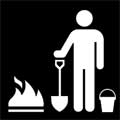DACF Home → Bureaus & Programs → Maine Forest Service → About Us → Forest Protection → Programs & Services
Programs and Services
On this page:
- Recruitment
- Training
- Burning Permits
- Campfire Permits
- Federal Excess Property Program
- Volunteer Fire Capacity Program
- Causes of Wildfires
- Timber Trespass and Timber Theft
- Christmas Tree and Wreath Tipping Laws
- Northeastern Forest Fire Protection Commission
Recruitment
Forest Ranger II
This is protective and investigative services work in detection, prevention, presuppression, and suppression of forest fires and in enforcement of forestry, environmental, and conservation laws. Work includes preparing and updating fires action plans, training firefighters, and supervising firefighting operations; patrolling and inspecting an assigned area; observing, reporting, and prosecuting violations; investigating suspicious fires and suspected criminal activities; conducting public information and education programs; and preparing records and reports.
To be a successful forest ranger, an individual must possess considerable knowledge of basic forest fire control, safety, and basic forestry practices. One must also possess the ability to work independently over a large geographic area, establish and maintain effective working relationships in routine and emergency situations, work long hours, communicate effectively orally and in writing, use good judgment, and make sound decisions, all under adverse and stressful conditions.
If you have an interest in applying to become a Forest Ranger, please carefully review the minimum qualifications, testing and evaluation process below before contacting the Maine Forest Service at maine.forestrangers@maine.gov
- Forest Ranger II: Minimum Qualifcations and Testing/Evaluation Process (PDF)
- Forest Ranger Pilot: Minimum Qualifcations & Testing/Evaluation Process (PDF)
Contact the Forest Protection State Office for more information
Training
The Maine Forest Rangers frequently offer training opportunities to firefighters, fire departments, and logging contractors. Most training announcements are sent directly to cooperators who work with the Forest Rangers via email. Announcements are also sometimes posted on the Maine Forest Ranger Facebook page.
Burning and Campfire Permits
Burning Permits
Burning permits are required for out door burning of brush piles or wood debris anytime throughout the year. Depending on the current fire danger, restrictions may be in place. Before considering burning, check the daily fire danger rating and check with local fire officials or the Maine Forest Service.
The Maine Forest Service’s online burn permit system is a safe and convenient alternative to getting a hand written permit. The $7 fee for online burn permits was removed on October 18, 2021. There are also plans to make improvements to the online burn permit system during the winter of 2022 - 2023. FMI, please visit www.maineburnpermit.com and be sure to follow all the restrictions listed on the permit.
Hand written burning permits are still available.In organized towns, a permit can be obtained from the town forest fire warden, who is often also the fire chief.
In unorganized towns, a permit may be obtained from your local Forest Ranger or Forest Protection office.
Contact the Forest Protection office nearest you for more information.
FAQ’s on Maine’s open burning laws March 7, 2024 (PDF)
View State of Maine Rules and Guidelines for Open Burning (PDF | 13.4 KB)
Fire prevention tips for debris burning (PDF | 48 KB)
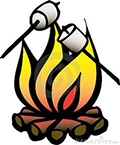
Campfire Permits
Campfire permits are different than brush pile permits and can not be obtained through the online burn permit system. Organized towns may have ordinances that require campfire permits, but the state does not require campfire permits for a small recreational campfire on property you own. If you desire to have a campfire in an organized town, please check with local fire officials or the town office to see if a campfire permit is required.
The Maine Forest Service only issues campfire permits for remote “permit” campsites in unorganized towns. The sites are pre-established (not wilderness sites) and campfire permits are only valid for a short period of time. Commonly used recreational maps of Maine distinguish between campsites that require a permit (permit sites) and a small amount of campsites (authorized sites) that do not require a permit.
Campfire permits for “permit” sites can be obtained by contacting the local forest ranger, but we recommend calling our regional headquarters Monday through Friday the day before you need the permit. They can also answer any questions about the type of campsite. Due to changing fire danger levels, campfire permits will not be issued more than two days in advance. To check the daily fire danger rating, please visit www.mainefireweather.org.
For more information, please call the Regional Headquarters close to where you want to have the campfire.
- Before you start your fire, make sure you have permission from the landowner and a campfire permit if required. Check the daily fire danger level to see how dry it is in your area (www.mainefireweather.org)
- Find a safe area to burn that doesn’t have overhead branches or dry grass and leaves nearby. Rake any leaves and needles away from the location of the campfire.
- It is unlawful to burn plastic, metals and glass, so set up a trash bag for those items and keep them out of the fire.
- Keep plenty of water handy and have a shovel available to extinguish any stray embers. You will also need the shovel to put the campfire out when it comes time to leave.
- Create a small pile of twigs, small sticks and a few pieces of paper. Do not use any accelerants. A wood match or butane lighter is all you should need.
- Once the fire starts, add a few larger sticks. As Smokey Bear says, “keep the fire small, not tall.”
- A large fire is much more dangerous and is also harder to put out if suddenly you have to leave.
- Supervise children and pets near the fire and never leave it unattended.
- When it comes time to leave, drown the fire with water, making sure all embers, coals and sticks are completely soaked. Use a shovel to move rocks to check for embers and stir / mix the coals with the water.
- Use the back of your hand to feel if the remaining coals are still hot. If you still feel heat, then add more water and stirs the coals repeatedly until no heat can be felt.


Federal Excess Property Program
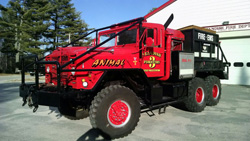
The Maine Forest Service (MFS) participates in the Department of Defense's (DoD)’s Firefighter Property program (FFP). This program is administered through the USDA Forest Service and allows the MFS to acquire federal surplus property and loan or transfer it to Maine fire departments. In most cases, the fire departments can receive title for vehicles and property obtained from this program after it has been in service for two years.
This is not to be confused with the older program called FEPP. The MFS no longer screens for that program and fire departments will not be able to receive title on any vehicles or equipment acquired through FEPP. Fire departments no longer actively using FEPP equipment are encouraged to turn that equipment in to the MFS for proper disposal.
All requests for federal excess property in the FFP program are routed through the local forest ranger. Requests are evaluated and placed on a priority list. As equipment becomes available, cooperators are notified as names appear on the priority list.
Since 2015, the MFS only accepts requests for from fire departments for wildland firefighting equipment acquired in the FFP program. Fire departments interesting in structural, emergency or rescue equipment should contact the Maine Fire Chiefs Association.
For more information on this program, contact a local forest ranger or the Federal Excess Property Manager.
Volunteer Fire Capacity Program
The purpose of the Volunteer Fire Capacity (VFC) Program, formerly known as the Volunteer Fire Assistance (VFA) Program, is to provide Federal financial, technical, and other assistance to State Foresters and other appropriate officials to organize, train and equip fire departments in rural areas and rural communities to prevent and suppress wildfires. A rural community is defined as having 10,000 or less population.
Each year, federal funds are appropriated to assist towns with the purchase of forest fire equipment or to provide forest fire training. Grants require that towns match the grant funds dollar for dollar.
The schedule for the VFC program in Maine has been adjusted in 2025 and is as follows:
- Mid-September – applications for the upcoming year are made available.
- Mid-December – deadline for applications.
- December – the Maine Forest Service (MFS) and Maine Fire Chiefs Association Forestry Committee review the applications and make recommendations for award amounts.
- Mid-January – award letters are sent via email.
- March – deadline for the signed agreement and assurances forms to be returned to the MFS.
- April / May / June / July – if paperwork is in order, reimbursements are issued to towns.
- July 31st – deadline for receipts and payment documentation to be turned in to MFS.
Download 2026 VFC Program Announcement (PDF)
For more information, contact the VFC Program Administrator.
Causes of Wildfires
Ninety (90%) of all wildfires in Maine are caused by people and are preventable. Only lightning caused fires cannot be prevented. Escaped debris fires, equipment-caused fires and unattended campfires continue to be the most common causes of wildfires in Maine.
Maine's wildfire season usually begins in March in coastal and southern sections, gradually extending to central, western and northern areas. The wildfire season usually ends in late November. The majority of wildfires usually occur in April and May, when home owners are cleaning up from the winter months, and when the majority of vegetation is void of any appreciable moisture making them highly flammable. Once "green-up" takes place in late May to early June, the fire danger usually is reduced.
Contact the Forest Protection office nearest you for more information.
Learning from the past: the 1947 fires in Maine
Timber Trespass and Timber Theft

It is estimated that Maine Forest Service Rangers investigate over 1000 complaints annually involving timber trespass or deliberate theft of timber. Timber harvesting is a large part of Maine's economy. However, often times property lines are not well defined resulting in timber being cut without the landowner's permission. In some cases, a few loggers specifically target forest landowners, especially non-residents and the elderly. Individuals who make their living stealing timber give the entire industry a black eye. The vast majority of forestry professionals are honest, reputable business men and women. Their ability to obtain timber harvesting contracts is hindered by this very small group of timber thieves.
As a forest landowner, here are a few steps you can take to prevent timber trespass/theft:
- Keep all property lines well marked and brushed out.
- Know who the adjacent property owners are.
- Have someone keep an eye on your property should you be unable to.
- Should you suspect someone is cutting wood on your property, call the nearest Forest Ranger.
- Never give oral permission for someone to harvest your timber.
- Always have a written contract for all timber harvesting.
- Keep all copies of scale slips and payment documents associated with each timber sale for at least one year after the timber harvest.
It is also helpful for landowners to know the laws that are designed to protect them from timber theft. Note: these laws are paraphrased, for exact wording please visit Maine Revised Statutes
- Title 17 S2512 states that timber harvesters shall pay the landowner within 45 days of delivering the harvested forest products to the mill.
- Title 10, section 2364-A, states that the timber harvester shall provide the landowner a copy of the measurement tally sheet or stumpage sheet for each truckload of forest products (which have been transported to the mill) at the time of payment to the landowner.
- Title 17 S 2510 states that a person can not cut down a tree without the landowners’ permission. If they do, they have committed a civil violation and may have to pay values set by the Legislature as restitution to the landowner plus additional fines to the State.
- Title 17 S 2511 states that the landowner (or landowner representative) shall clearly mark any established property lines within 200’ of the area to be harvested. The marking must be completed prior to the start of the timber harvest and must be clearly visible. The marking of trees could be more permanent with blazes and paint or temporarily, with flagging or surveyors tape.
- Title 17 S 2511 also states that a line tree (a tree located near the boundary line that has been blazed or painted) can not be cut without first obtaining permission from the abutting landowner.
Contact the Forest Protection office nearest you for more information.
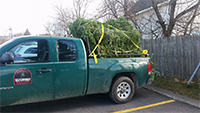
Christmas Tree and Wreath Tipping Laws
It is estimated that 2-3 million Christmas wreaths are made each year in Maine, making it one of the largest seasonal industries in our State. It takes an average of 3-5 pounds of brush to make one wreath. Fir and pine tips or brush are among the most in demand. The supply comes from both small and large woodland ownerships. The harvesting of wreath brush or tips is commonly referred to as "Tipping". Maine Forest Service rangers spend a great deal of time enforcing these and other related laws. The "Tipping" season usually begins in early November and ends around the second week of December.
It is unlawful for any person, firm or corporation to cut or transport Christmas trees or evergreen boughs (Tips) on land of another without securing written permission or bill of sale from the owner or his authorized agents. In the case of cutting, only one such permit is needed per work crew. When engaged in the cutting or transporting of Christmas trees or evergreen boughs the following is required:
- Cutting. If engaged in cutting, a current written permit or bill of sale from the owner when cutting growth of another.
- Transportation. If engaged in transportation, a current written permit, bill of sale, port of entry statement or other written proof of ownership when transporting for commercial purposes trees, loose or in bundles, or boughs, loose or baled. A driver shall carry this permit on his person or in the vehicle.
Contact the Forest Protection office nearest you for more information.
Northeastern Forest Fire Protection Commission
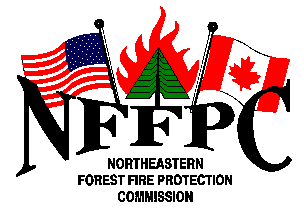
The Maine Forest Service is a member of the Northeastern Forest Fire Protection Commission or "Compact" which was formed shortly after the devastating forest fires of 1947. Members include all the New England States, New York, the Provinces of New Brunswick, Quebec, Nova Scotia, Newfoundland, and Labrador, plus the New England Forest which includes the White, Green and Finger Lakes Forests. This Compact was assembled to bolster fire suppression capabilities, as well as meeting training needs. Equipment and manpower are often called upon during the forest fire season, greatly increasing each member's fire fighting arsenal. The full membership meets each year during a week long winter training/meeting session. Former State of Maine-Forest Commissioner Austin H. Wilkins was instrumental in forming the Compact, in 1949.
For more information you may e-mail the Executive Director-Tom Brady at tbrady@nffpc.org
The Northeastern Forest Fire Compact Web site is located at: http://www.nffpc.org/
For fire prevention tips from the Compact’s Fire Prevention and Education Working Team, please visit: www.northeastwildfire.org
